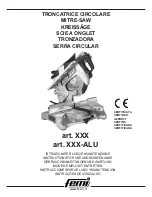
-4-
•
Do not feed workpiece into the blade or cut
“freehand” in any way. Workpiece must be
stationary and clamped by provided clamp.
Saw must be fed through the workpiece smoothly
and at a rate which will not overload the saw’s
motor.
•
Cut only one workpiece at a time.
Multiple
workpieces cannot be adequately clamped and
may bind on the blade or shift during cutting.
•
Be certain the saw is mounted or placed on a
level, firm work surface before using.
A level
and firm work surface reduces the risk of the saw
becoming unstable.
•
Plan your work. Provide adequate support
accessories such as tables, saw horses, table
extension, etc. for workpieces wider or longer
than the table top (see page 16)
. Workpieces
longer or wider than the saw base can tip if not se-
curely supported. If the cutoff piece or workpiece
tips it can lift the lower guard or be thrown by the
spinning blade.
•
Do not use another person as a substitute for
a table extension or as additional support.
Unstable support for the workpiece can cause the
blade to bind or the workpiece to shift
during the cutting operation pulling you and the
helper into the spinning blade.
•
The cutoff piece must not be jammed against
or pressured by any other means against the
spinning saw blade.
If confined, i.e. using length
stops, it could get wedged against the blade and
thrown violently.
•
Always use a clamp or a fixture designed to
properly support round and/or irregularly
shaped material such as pipes, or tubing.
Pipes and irregularly shaped workpieces have
tendency to twist, rock, or slip while being cut,
causing the blade to “bite” and pull the work with
your hand into the blade.
•
Let the blade reach full speed before contact-
ing the workpiece.
This will help avoid thrown
workpieces.
•
If the workpiece or blade becomes jammed or
bogged down, turn the saw “OFF” by releas-
ing switch. Wait for all moving parts to stop
and unplug the saw, then work to free the
jammed material.
Continued sawing with
jammed workpiece could cause loss of control or
damage to the saw.
•
Braking action of the saw causes the saw
head to jerk downward.
Be ready for this
reaction when making an incomplete cut or when
releasing the switch before the head is completely
in the down position.
•
After finishing the cut, release the switch, hold
the saw arm down and wait for blade to stop
before removing work or cutoff piece. If blade
does not stop within twelve (12) seconds, un-
plug the saw and follow the instructions in the
Troubleshooting section.
REACHING WITH
YOUR HAND UNDER A COASTING BLADE IS
DANGEROUS!
•
There are additional safety instructions for
particular operations of the saw in the operat-
ing section. Read the rest of the manual for
safe operation.
•
For chop action cutting, turn the saw “ON”
and lower the head assembly to make the
cut. Release the switch and wait for the blade
to completely stop before raising the head
assembly and removing the workpiece.
•
Do not allow familiarity gained from frequent
use of your saw to become commonplace.
Al-
ways remember that a careless fraction of a sec-
ond is sufficient to inflict severe injury.
• THINK SAFETY! SAFETY IS A COMBINATION
OF OPERATOR’S COMMON SENSE, KNOWL-
EDGE OF THE SAFETY AND OPERATING IN-
STRUCTIONS AND ALERTNESS AT ALL TIMES
WHEN THE SAW IS BEING USED.
SAVE THESE INSTRUCTIONS
READ ALL INSTRUCTIONS — Failure to follow the SAFETY RULES identified by
BULLET (•) symbol listed BELOW and other safety precautions, may result in serious
personal injury.
Safety
1609B00427 eng.qxp_SPT62MTC 5/12/15 1:53 PM Page 4





































